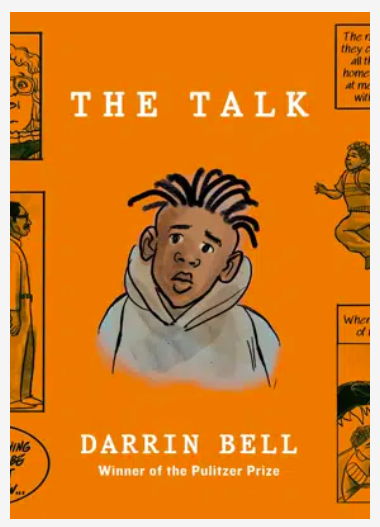
By DONNA EDWARDS, AP News
“The Talk” by Darrin Bell (Henry Holt & Company)
Seeing the other children at the park playing with water guns, Darrin asks his mom for one. Her immediate response: No.
Pulitzer Prize-winning editorial cartoonist Darrin Bell’s graphic memoir “The Talk” begins around age 6, when his mom first has “the talk” with him — the one about racism, fear and police brutality and the reason he can’t have a realistic water gun like the other kids. It follows him into adulthood, when he is confronted with having the talk with his own son.
The result is a thought-provoking memoir beautifully rendered in expressive artwork for a powerful piece that’s easy to devour but harder to digest.
From anxiety-inducing encounters with the police to the space shuttle Challenger’s failed mission and explosion, Bell presents his childhood with a graphic vulnerability. Jumping into young Darrin’s mind, showing him as Luke Skywalker training with Yoda, Bell captures the imagination of a child so thoroughly that the heavy, adult topic of police brutality stands in even starker contrast.
Both metaphorical and artistic contrast are well-used in “The Talk.”
Cool blue and black tones illustrate each page. Sparks of vibrant green and red, and even full-spectrum color, highlight and intensify something as small as an object within a panel, or as big as a full-page spread. The line work is fairly simple but the shading is complex. Faces are expressive but rarely cross the line into cartoonish. The lettering is a highly readable alternative to Comic Sans that retains the handwritten look.
A chapter set in 2015 with a hopeful end is immediately contrasted when the next chapter, set a few months later, begins with a hateful, racist quote in red against a black background that readers will immediately recognize as Donald Trump’s words.
Presenting the quote stark and glowing, Bell asks readers to consider that this rhetoric got a man elected to the highest position in the United States government.
There’s a series of close-ups on Trump’s eyes that reflect scenes of nationalism and violence. The depictions’ broader color palette adds emphasis, undercutting the next, mostly monochrome scene, depicting Bell reflecting on his Pulitzer win for editorial cartoons calling out the Trump administration.
Rather than an exuberant, brightly colored celebration, Bell depicts the scene as dull, depressing, drained of life.
But not all the stories are so heavy. The chapter “All The Way Down” is about Bell making friends who become his core crowd. It captures the uneasiness of injecting yourself into a friend group, as well as the joy of being accepted and appreciated as part of that group.
In his acknowledgments, Bell says penning the book made him feel those feelings anew. And it shows. The images and words practically vibrate with feeling: palpably hot anger and cold isolation and warm affection. Seeing him make the choice after George Floyd was murdered to preserve his then-6-year-old son’s innocence for one more day, one more month, during the already tenuous early pandemic, is enough to draw tears.
Bell’s mastery of the medium shines throughout “The Talk” with stunning artwork that heightens the story to 11.

